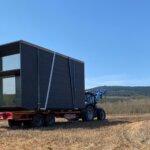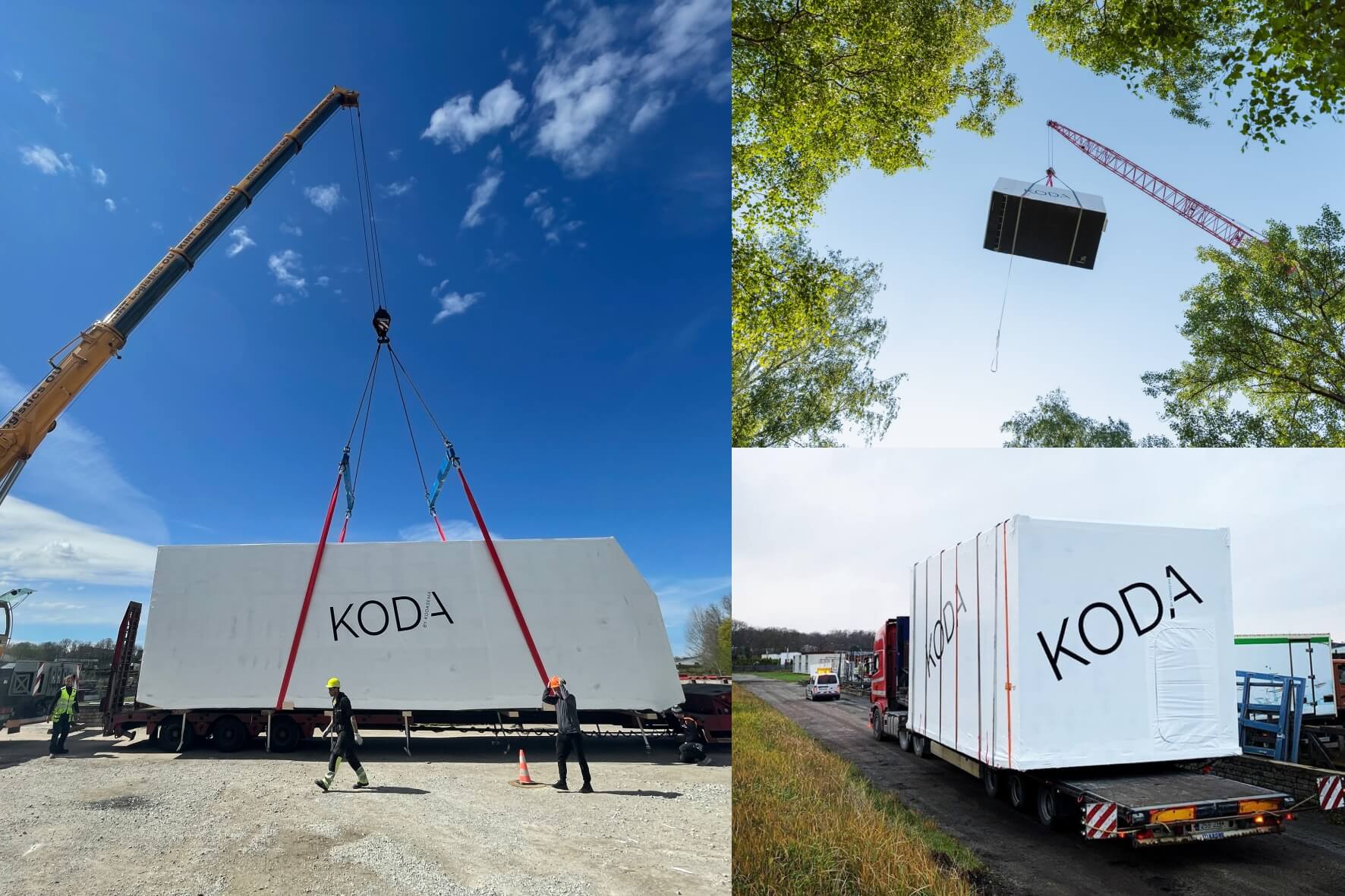You want your KODAs to arrive safe and sound, so here’s an overview of do’s and don’ts of KODA delivery* – as well as examples of how KODAs are being lifted and handled.
As all KODA fans know by now, all your houses are delivered ready-for-use (turn-key in fancy house construction lingo) to your dream destination, so there is no assembly on location at all, just lifting your KODAs off the trailers and connecting to the utilities/mains by a local contractor. Therefore, prior to purchasing KODAs, you need to know whether your site is easily accessible for a low-bed truck and a crane. That’s a critical issue.
The bigger your chosen KODA model, the bigger the crane capacity needs to be – the lifting radius is to be determined by your local crane operator, based on the weight of your KODA model and the distance between the foundation, the trailer and the crane. Luckily, timber frame KODAs weigh between just 6-15 tonnes, and require only 4.5 m of road width to pass through. For some routes, tunnels have to be considered, too: a KODA on a truck requires a minimum height of 4.40m.
We’re champions at designing and producing your houses, but any site preparations are the client’s responsibility. So, before your KODAs arrive, the foundation posts as well as the connection points (for electricity, water and wastewater) need to be ready for a smooth and quick installation. It is recommended to involve a local specialist partner for the work. But worry not! We will provide you with all the installation and handling guidelines and site preparation requirements you’ll need to make the installation a success. Just bear in mind that several aspects are site-specific and can only be determined by a local architect or engineer.
 So, how do we arrange the delivery of your KODAs? Prior to contracting, we figure out the site access with our logistics partner, as well as costs of delivery and time required for road permits. “We only work with professional partners, who are experts in the field of oversized cargo and know which institutions to contact, how to apply for relevant road permits, learn whether any traffic signs need to be removed, or police escorts arranged according to local regulations,” says Mr Heido Türk, Kodasema’s Technical and Logistics Manager, the man who’s orchestrated the safe delivery of most of the KODAs you’ll spot anywhere in the world.
So, how do we arrange the delivery of your KODAs? Prior to contracting, we figure out the site access with our logistics partner, as well as costs of delivery and time required for road permits. “We only work with professional partners, who are experts in the field of oversized cargo and know which institutions to contact, how to apply for relevant road permits, learn whether any traffic signs need to be removed, or police escorts arranged according to local regulations,” says Mr Heido Türk, Kodasema’s Technical and Logistics Manager, the man who’s orchestrated the safe delivery of most of the KODAs you’ll spot anywhere in the world.
Once that’s settled we move on to contracting, and if necessary, a transport surcharge is added to the Sales Agreement. This is also the time to make contact with your preferred local crane company. About 4 weeks prior to delivery, the road permits will be processed and your exact delivery schedule will roll out. As soon as all the road permits have been granted and ferry tickets booked where needed, you can liaise with your local crane operator to fix your unloading date.
Depending on the size and destination of your KODAs, the houses are usually loaded on a low-bed truck and reloaded to a flat rack for shipping at a cargo port. At the destination port, the KODAs will be re-loaded to a local low-bed truck and delivered to the customer.
In the event of a more complex destination (i.e. driving over farmland), the KODAs are unloaded at a depot and this is where the responsibility will be transferred over to the customer.
 According to Heido Türk, it is not all black and white with deliveries. “Our experience has shown that no matter how well everything has been pre-arranged, issues can come up with oversized cargo, especially with the largest KODA models. Some off-the-chart examples from past feature the truck breaking down and causing delay, local police deciding just a bit before the destination that the permit will run out before reaching the finishing line, and a new permit will need to be applied for (with 4 weeks stand-by), or the ferry captain stopping KODA onboarding due to high tide, and whatnot. Sounds a bit scary? No fear, all the houses I’ve just described were delivered safe and sound.”
According to Heido Türk, it is not all black and white with deliveries. “Our experience has shown that no matter how well everything has been pre-arranged, issues can come up with oversized cargo, especially with the largest KODA models. Some off-the-chart examples from past feature the truck breaking down and causing delay, local police deciding just a bit before the destination that the permit will run out before reaching the finishing line, and a new permit will need to be applied for (with 4 weeks stand-by), or the ferry captain stopping KODA onboarding due to high tide, and whatnot. Sounds a bit scary? No fear, all the houses I’ve just described were delivered safe and sound.”
To be on the safe side, KODA transport, whether road or sea, is always insured. But do remember to check the insurance of your locally sourced unloading crane.
As mentioned above, we will give you detailed guidelines for unloading and installation. But here’s couple of important things that you need to know:
- DO always use transport beams under your KODAs, so that the structure would not be damaged. Keep this in mind especially in the event of re-loading the KODA in a depot
- DO use cargo straps to attach your KODAs to the trailer
- DO use certified webbing slings for lifting. There is a pair included with your KODAs, find it on the terrace
- DO only place your KODAs on levelled supports, should you need to store the houses before lifting to desired end location (e.g. in case your site is not ready by the time of delivery)
- DO unwrap your KODAs before unloading in case you are placing several KODAs side-by-side; a single-standing KODA can be unwrapped before or after the unloading, whichever you prefer
- DO always use corner protection both on the roof and foundation under the straps when lifting, to avoid deformation
- DON’T leave your KODAs hanging on a crane
- DO always place the back of your KODAs facing driving direction, when relocating
That’s it! For other instructions carefully follow Kodasema official unloading manual. That’s how your KODAs will arrive safely and what it takes to get them on the road – and you’ll have our tech and delivery team led by Heido Türk to make the process smooth!
*European models
